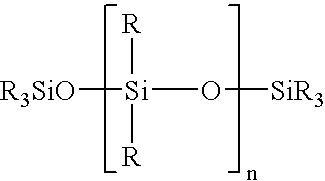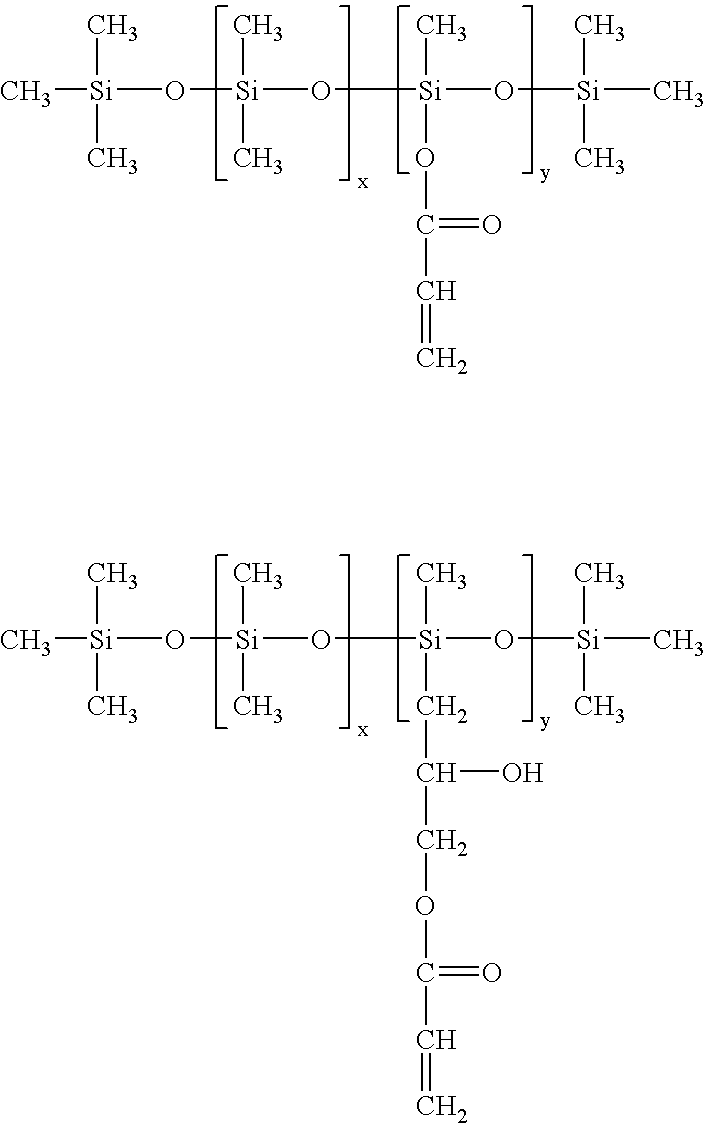Non-volatile lubricant system for medical devices
a lubricant system and non-volatile technology, applied in the direction of packaging, pharmaceutical packaging, group 4/14 element organic compounds, etc., can solve the problems of patient discomfort, ease of insertion, volatile solvents such as cfc's, and raise significant environmental concerns, and achieve low viscosity, effective delivery of composition, and low viscosity
- Summary
- Abstract
- Description
- Claims
- Application Information
AI Technical Summary
Benefits of technology
Problems solved by technology
Method used
Image
Examples
example 1
[0058]Example 1 demonstrates a comparison of a catheter assembled with a coating composition according to the present invention which does not include any volatile organic solvent versus a comparative catheter coated with a conventional catheter lubricant coating composition including volatile organic solvent as a carrier medium.
[0059]In comparative Sample 1, a 20 gauge (ga) polyurethane catheter product was assembled by using a catheter tipping lubricant including an amino-functional silicone dissolved in a CFC-like volatile solvent for tipping the catheter to form a taper in known manner. A needle lubricant including a high viscosity polydimethyl siloxane dissolved in a CFC-like volatile solvent was then applied to the needle cannula by dip coating and allowing the solvent to evaporate before the catheter is placed over it. A catheter lubricant including a polydimethyl siloxane dissolved in a CFC-like volatile solvent was then applied over the entire finished product by dip coatin...
example 2
[0066]Example 2 demonstrates a comparison of Teflon catheters coated with a coating composition according to the present invention which does not include any volatile organic solvents as compared with a conventional solvent-based coating.
[0067]In comparative Sample 3, a set of fifteen (15) 22 gauge Teflon catheters (Angiocath Autoguard) were tapered by using a catheter tipping lubricant including a water-based silicone for tipping the catheters to form a taper in known manner. A solvent-based needle lubricant as set forth in Sample 1 above was used for assembly of the catheters. A solvent-based catheter lubricant as set forth in Sample 1 above was then applied over each of the assembled catheter products by dip coating and allowing the solvent to evaporate.
[0068]Separately, a catheter lubricant according to the present invention was prepared as Sample 4 according to the formulation in Table 3:
[0069]
TABLE 3Sample 4Acrylated silicone (%)12.3(Rhodia Silcolease PC-970)12,500 cstk polydi...
example 3
[0074]Example 3 represents a comparative example demonstrating a stainless steel needle cannula with a conventional volatile organic solvent-based needle lubricant, according to the following composition in Table 4:
[0075]
TABLE 5Sample 5(comparative)Partially cured organosiloxane3.8copolymer, polydimethylsiloxane,and amino-containingsilicone polymer (%)CFC-like volatile solvent (%)96.2
[0076]A 22 gauge H1000 stainless steel needle cannula was coated with the composition of comparative Sample 5 by dip-coating, and the solvent was evaporated. Peak penetration force (F2) and drag force (F4) were measured, with the results used for normalized comparison in Example 4.
PUM
| Property | Measurement | Unit |
|---|---|---|
| Percent by mass | aaaaa | aaaaa |
| Percent by mass | aaaaa | aaaaa |
| Percent by mass | aaaaa | aaaaa |
Abstract
Description
Claims
Application Information
 Login to View More
Login to View More - R&D
- Intellectual Property
- Life Sciences
- Materials
- Tech Scout
- Unparalleled Data Quality
- Higher Quality Content
- 60% Fewer Hallucinations
Browse by: Latest US Patents, China's latest patents, Technical Efficacy Thesaurus, Application Domain, Technology Topic, Popular Technical Reports.
© 2025 PatSnap. All rights reserved.Legal|Privacy policy|Modern Slavery Act Transparency Statement|Sitemap|About US| Contact US: help@patsnap.com



